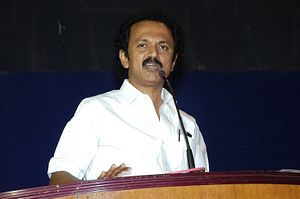Stalin ruled not only over the Soviet Union. Stalin has also been the mayor of Chennai, one of India’s biggest cities and the capital of the state of Tamil Nadu. The second Stalin is M.K. Stalin, a Tamil politician and the son of a famous leader, M. Karunanidhi. He is, however, easily the most popular among a handful of Indian Stalins, Lenins, and Khrushchevs. They remain as a symbol of an old and marginal naming fashion that raises a lot of eyebrows in Europe and the United S.
In 2016, when the state of Tamil Nadu held its last state assembly polls, the election was mostly a contest between two parties – AIADMK and DMK – and their allies. At the time, AIADMK was still led J. Jayalalithaa and DMK by M. Karunanidhi. Both, however, had lived long political lives and both have since passed away — Jayalalithaa in December 2016 and Karunanidhi in August 2018. While the loss of Jayalalithaa left AIADMK in disarray for some time, it seems that in DMK with the recent death of Karunanidhi the mantle will be passed on to his son, M.K. Stalin. If so, sooner or later he may become the chief minister of the state of Tamil Nadu. Still, there is little chance that his hypothetical future successes will make his name less uncommon.
Unsurprisingly, the occasional naming of sons after Stalin, Lenin, Brezhnev, or Khrushchev in India is usually connected with a love for communism. As for daughters, in Kerala one can even, if very rarely, stumble upon women named Pravda (“truth” in Russian), after the Soviet newspaper. Historically, communist parties had been the strongest in the states of West Bengal, Kerala, and Tripura and this has more or less remained true. Communism was, however, more popular in India in the 1950s and 1960s, and in smaller degrees through the fall of the Soviet Union, than it is now.
Mohit Sen, a communist politician from Bengal who had become disenchanted with his party, recalled in his autobiography how the cult of Stalin reigned supreme in the Communist Party of India in the early 1950s. Even years after his demise, some among the Indian comrades apparently upheld Stalin as a great leader, rather than considering Stalin’s unimaginable crimes. At this point it is also worth mentioning that before the bonhomie that flourished between New Delhi and Moscow from the 1950s through the 1980s, the Soviets had initially opposed accepting India’s independence and called on the Indian communists to take up arms against their own government.
Among the three above-mentioned states where red is still an intense color, it is in Kerala where some of the members of the radical left used to follow this peculiar naming fashion, though it was apparently always a marginal phenomenon. Kerala is also where the first state-level communist government was formed, back in the 1950s. Thus, a few Keralites were named Pravda, Lenin, Stalin, Brezhnev, Khruschev, Mao, Trotsky, or Che Guevara. Some other names were more neutral and related to Russian culture and traditions, rather than communist ideology: Pushkin, Tanya, or Olga. There is even a village in Kerala – yes, of course it is called Moscow – where meetings of the region’s Stalins and Lenins are still being held. However, judging by media reports, the gatherings are quite small.
Aside from Kerala, one can find some Lenins and Stalins in neighboring Tamil Nadu. Communist parties, however, were never strong in the state. So where did the Tamil Stalins and Lenins come from?
Let’s look at M.K. Stalin. In 1953, the birth of M. Karunanidhi’s son nearly coincided with Stalin’s death. The politician therefore decided to name his son after the Soviet ruler, although earlier he had been planning to choose a Tamil name. M. Karunanidhi went on to become the supreme leader of his party, the DMK (Dravida Munnetra Kazhagam). He had also groomed his son as his heir to the party throne. It was this development that gave his son’s name some power and fame, rather than the Soviet namesake.
Although not really communist, the DMK flowed down the river of a political tradition that had been born of a few streams: the struggle of lower classes for social and political uplift, the Tamil-speaking people’s self-assertion movement, opposition against the dominance of Hindu priests (Brahmans), and combat against religion. While some of the streams have dried up – the element of opposing religion has nearly completely disappeared – back in 1953 they were seemingly strong enough to motivate M. Karunanidhi to pick’s Stalin’s surname as his son’s name. Thus, a juncture of political trends and chronological coincidence led to a choice of a name that perhaps would have not been selected by M. Karunanidhi just a few years later.
Perhaps similar political winds scattered a few other Stalins and Lenins across Tamil Nadu. The 2014 general elections in India where contested by one independent Tamil candidate named Lenin. As decades pass, it becomes less clear to what extent such rare names are chosen to deliberately relate to communism or Soviet Russia. If someone chooses to call his son Stalin nowadays in Tamil Nadu, is it because of Joseph Stalin, or the regionally more relevant M.K. Stalin? The latter leader himself admits that his name is an exception and that he would prefer the Tamil people to choose Tamil names for their progeny.
Somewhat ironically, if in the future M.K. Stalin becomes the chief minister of Tamil Nadu, it will be during a period when the tide of communism in India is at its lowest point.

































